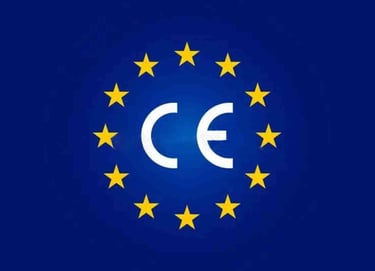
CE MARKING CERTIFICATE
CE Marking (Conformité Européenne - European Conformity) is a mark indicating that a product complies with the health, safety, environmental, and consumer protection requirements necessary for it to be sold within the European Union (EU). It signifies that the manufacturer declares that their product conforms to the relevant EU directives (regulations) and has completed the necessary conformity assessment procedures.
Difference Between CE Marking and CE Certificate:
Although it is often referred to as a "CE Certificate," there is no official separate document. The CE marking is the mark affixed to the product and is the visual indicator of conformity. The declaration of conformity and technical documentation remain with the manufacturer and are presented to the competent authorities upon request. In other words, the CE marking is meaningful because of the technical file and declaration of conformity that support it.
Purpose of CE Marking:
Free Movement: To ensure the free movement of products within the EU market.
Safety: To ensure that products are safe for users and the environment.
Health and Environmental Protection: To ensure the protection of human health and the environment.
Preventing Unfair Competition: To prevent unfair competition by ensuring that all manufacturers comply with the same rules.
Consumer Confidence: To assure consumers that the product meets certain standards.
Which Products Must Carry CE Marking?
CE marking is mandatory for many product categories covered by EU directives. Some of these categories include:
Toys
Electrical and Electronic Equipment
Machinery
Medical Devices
Lifts
Personal Protective Equipment
Gas Appliances
Pressure Equipment
Construction Products
Equipment for Use in Potentially Explosive Atmospheres (ATEX)


How to Obtain CE Marking?
The process for obtaining CE marking varies depending on the type of product and the relevant directives. The general steps are:
Identification of Relevant Directives: Determining which EU directives the product falls under.
Selection of Conformity Assessment Procedure: Selecting the conformity assessment procedure specified in the relevant directive. This procedure varies according to the risk level of the product and may include different options ranging from the manufacturer's self-declaration to the involvement of a Notified Body.
Preparation of Technical File: Preparing the technical file containing the product's technical specifications, design, production process, and conformity assessment results.
Performing Conformity Assessment: Evaluating the product's compliance with the requirements of the relevant directive through tests, analyses, and inspections.
Preparation of EU Declaration of Conformity: Preparing the document in which the manufacturer declares that their product complies with the relevant directives.
Affixing CE Marking to the Product: After all requirements have been met, affixing the CE marking visibly, legibly, and indelibly to the product, its packaging, or accompanying documents.
Contact Us to Begin Your CE Marking Process.
We offer affordable and effective solutions tailored to your needs.
The information presented on this website does not constitute legal advice and is intended for informational purposes only. KompassEurope.com.tr assumes no responsibility for any errors or omissions in the information contained on this website. Any decisions made or actions taken by the reader based on this information are solely at the reader's own risk, and KompassEurope.com.tr shall not be held liable for any legal consequences arising from such decisions or actions. Readers are strongly advised to seek professional legal counsel regarding their specific circumstances and concerns.
© 2025 Kompass Europe. All rights reserved. The contents of this website belong to Kompass Europe and are protected by copyright laws. Copying, publishing, distributing or any commercial use of the information on the website is possible only with written permission. By using this site, you agree to our Terms of Use and Privacy Policy.
